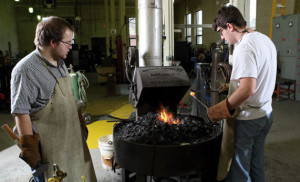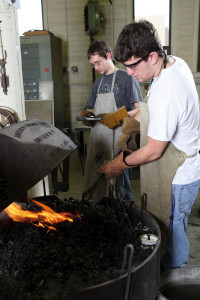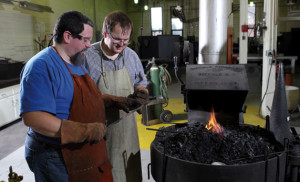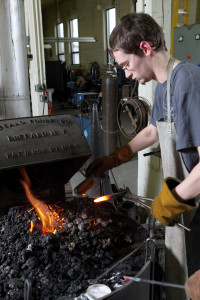After decades of silence, blacksmithing, a major component of the old metal working curriculum in the College of Engineering at SDSU, is breathing once more.
Blacksmithing was the thing in its day—a craft that dates back hundreds of years. Using a forge with extremely high heat, a blacksmith creates objects from wrought iron or steel by using tools to hammer, bend and cut.
They welded objects such as gates, grilles, railings, light fixtures, furniture, sculpture, tools, agricultural implements, decorative items, cooking utensils and weapons.
During World War II, SDSU was involved with the national defense training program that taught students for welding positions in shipyards.
However, beginning in the 1950s, blacksmithing began to phase out with more concentration put on arc welding—a type of welding that uses a welding power supply to create an electric arc between an electrode and the base material to melt the metal.
In the Agricultural Heritage Museum archives a photo exists that shows 12 forges that once stood in the old blacksmithing shop of Solberg Hall. They are all gone now – pushed aside in the name of advancing technology – except for one forge that serves as a proud reminder of the past.
That lone soldier caught the attention of engineering instructor Jason Prout when he came for his initial job interview in summer 2011.
“They took me on a tour of the building, and when I went through the shop, I went wow, they have a coal forge and this is so cool,†says Prout, who specializes in engineering design. “Once I got here and secured the position I was asked what I would like to be involved in and I said I’d love to get a blacksmithing club going and they were very supportive of
that idea.â€
Interested at young age
Prout arrived from Kirtland Community College, an engineering design technical school in Kirtland, Mich. His father was a shop teacher and young Prout grew up spending weekends in the wood shop.

The forge in the blacksmithing shop of Solberg Hall runs hot for engineering students Logan Janssen, right, and Chad Guzinski as they work on their blacksmithing creation.
“I got very used to hand skills,†says Prout, who became heavily involved in Boy Scouts, which exposed him to other things like blacksmithing when going to historical events and seeing blacksmiths at work. “That really piqued my interest, watching the guys swing hammers and bending steel.â€
Prout spent the first five weeks getting the equipment functional and double-checking to make sure it was safe to operate.
After years of inactivity, he chuckles when recalling one day when he was wiping dust from the forge. “I was afraid I was going to get in trouble with the guys in the shop because you looked around in the room and there was this black haze everywhere.â€
Finally, during Hobo Day weekend 2011, Prout was ready to demonstrate some blacksmithing before a gathering of 50 people made up mostly of students and a handful of faculty.
After 20 minutes getting the forge hot with coal and coke (popcorn version of coal) burning brightly, he took a big piece of steel and went through all the bending processes.
“It went over very well and that was basically the kickoff to getting the club going,†says Prout, who indicates the necessary paperwork hasn’t been turned in yet to make the club an official student organization.
“Once that gets in place it can become a sponsor for a wider community organization,†he says. “That’s the eventual goal because one of the things in blacksmithing is that it becomes a brain trust of people where skills are passed on and the whole group gets better as you go forward.â€
Controlling heating process
The club currently numbers 20 students, mostly from mechanical engineering. They meet every Friday afternoon, and according to Prout, “They are having a blast, plus it gives them great experience and it has historical value.â€

Logan Janssen, right, inserts a blacksmithing tool into the hot fire as Michael Knofczynski holds a tool for his turn at the forge.
Students don all the necessary clothing with heavy gloves, aprons and safety glasses.
“We’re very careful about safety, making sure they know how dangerous it is because you are dealing with a lot of heat,†says Prout. “You’re working with forces of coal and fire that you may have learned about, but never actually did. For students who have done welding, this (blacksmithing) is where welding came from.â€
Students learn how to control temperature and “it’s really interesting what you can do with metal when it reaches its yield point, where you can bend it, do twisting and all sorts of neat things,†says Prout, who observes that students usually have some background in welding and machining, but have never worked with
heat before.
Forever the teacher, one of Prout’s first assignments is to give them a quarter-inch rod of steel and instruct them to make a spoon. He’s had students who have succeeded in the endeavor, but the point is not to make a spoon, but to understand the process, he says.
“The point is you hammer it, heat it, and you learn to balance the heat so you don’t overheat the metal because it will turn into a sparkler if you do. As you hammer it thinner it heats up faster so you need to watch the heat. Invariably, most of the students will burn off their metal at some point, but I will just say, ‘Keep working, you’ll get better.’ It’s a difficult thing to master, but the more they do it, the better they will become.â€
Chad Guzinski, a senior majoring in manufacturing engineering technology, is quickly learning the balancing act.
“I’ve burnt off a lot of pieces of metal,†he says with a grin. “We all make some mistakes, but it doesn’t hurt too much. We learn as we go, especially how to control the heat.
“For me personally, I just really enjoy working with my hands and anything that I can get in and work on, I like doing. From an educational standpoint there is a lot of history to it. Although the equipment and technology is further along these days, the basics are all here in forging and blacksmithing.â€
Artistic, commercial needs
Prout, who took a formal blacksmithing course and was certified by the Midland (Mich.) Historical Society, says blacksmithing today still plays a role, but offers that it falls more into the hobby arena.
“It’s part of the artistic movement, but it’s also about specialized skills and there are places in the country where you can get a degree in blacksmithing,†he says. “Yes, it’s a niche area, but anything that’s artistic in general is a niche.â€
Says Guzinski, “Blacksmithing these days is definitely a transition from functional to artistic. Most of the people doing blacksmithing are doing it to make artistic things.â€
When it comes to commercial applications, the artist aspect of blacksmithing is huge, according to Prout.
“There are many places who specialize in restoration projects and blacksmithing is one component of the kind of skills necessary to work in that area.â€
Whether it’s an artistic calling, a hobby craft or commercial in nature, blacksmithing is once again stoking the educational flame in the College of Engineering.
“I look at it as a historical component of the college, because it’s important to recognize where we came from,†says Prout. “If you have all these different skills someone can do, and you pick this group of skills and advance them, every so ofte
n it’s important to look back and say what was that whole set of skills?
“We do things in blacksmithing that people basically don’t do much of in industry. Why not move these skills forward? But to move them forward we have to understand how they were done and so that’s what we are doing here with this blacksmithing club.â€
Kyle Johnson









I thought Jason may appreciate hearing from someone who stood at one of those 12 forges. I enrolled at “State” in September 1953 after a stint in Korea. As I recall all freshman engineering students were required to take the Forging class. I have and occasionally use my 6″x3/16″ center punch that earned me an “A” in that class.
Mr. Markus,
Just found this site while looking for blacksmith stuff. Didn’t know it was here. Please email me at sdstate.edu
I would love to hear more. jason.prout@sdstate.edu